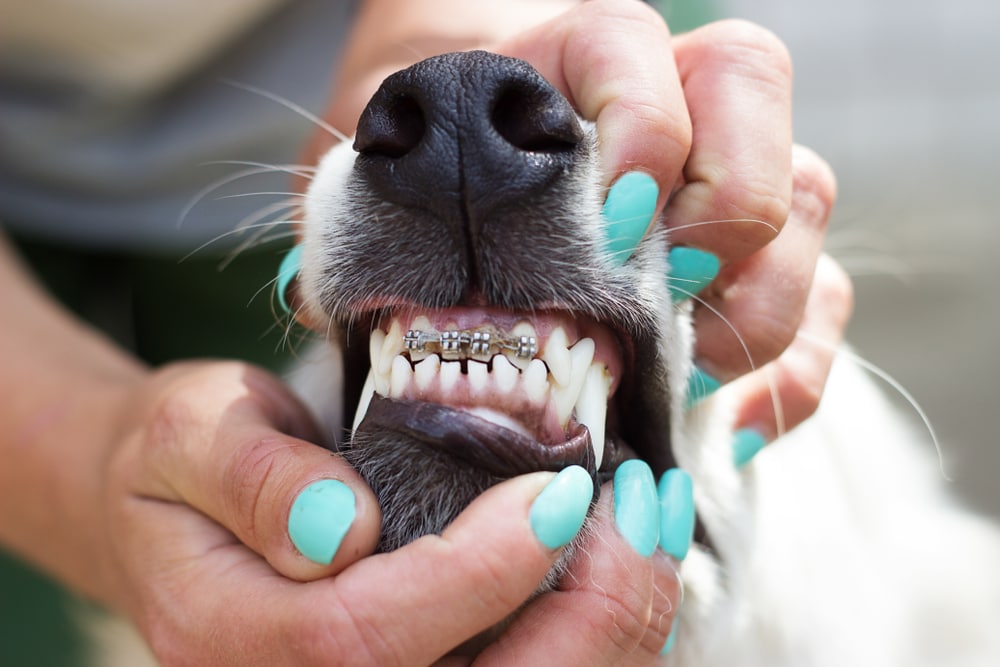Nothing invokes the memory of childhood pastimes like the movie Peter Pan. When it first hit the scene in 1953, Peter Pan captured the hearts of children all over America. Not only did we fall in love with Peter Pan, but we also quickly fell in love with Nana, the family’s nursemaid–who just happened to be a dog.
And in 2002 when Disney made the Peter Pan sequel “Return to Never Land” many of us remembered why we grew to enjoy the adventures of Never Land in the first place. Nana was loyal, funny, and kept us entertained all throughout the film. But what breed of dog is Nana?
Nana is a St. Bernard and interestingly had many of the personality characteristics of this specific dog breed. Nana had the usual brown and white spotted coat and heavy build that St. Bernards are known for. She was just as friendly, active, and energetic, which is one of the main reasons why people love having Saint Bernards as family dogs.

Appearance & History of St. Bernards
The St. Bernard dogs are believed to have come from Switzerland. Their use in rescue dog duties in the Alps can be traced back to the late 1600s. AKC (American Kennel Club) recognition of this breed was achieved in 1885. The average St. Bernard is about 25 to 27 inches in height and weighs anywhere from 110 to 215 pounds. Their coat is medium length, dense, and has a smooth texture. There are two types of St. Bernards, short-haired and long-haired. On average these dogs will have anywhere from 8 to 9 years.
Grooming St. Bernards
You can expect a lot of shedding with these dogs due to their large size and dense coat. Saint Bernard shed can be controlled, just like other large dog breeds. Here are a few ways to keep it to a minimum.
Weekly Brushing
The time spent grooming your St. Bernard will pay off in the long term. No matter what type of coat you have, the shedding is extreme and an ongoing issue. But St. Bernards with long hair are more likely to have tangles or knots in their coats. This is why brushing should be done daily in many cases–particularly in spring and autumn when they shed the most.
However, in some cases brushing anywhere from three to four times a week may suffice. Many groomers recommend that you use a curved, toothed brushing instrument to help protect their undercoat while removing any loose or dead hairs on their topcoat.

Bathing
Believe it or not, St. Bernards don’t need to take baths often. Your St. Bernard can be bathed as often as it needs, but only if it’s particularly dirty or smells like an outside dog. Regular bathing will decrease the amount of oil in your dog’s coat, and this oil helps maintain hair and coat health.
So, bathing your dog no more than once a month is ideal. And during the bathing process, be sure to start at the end of the coat and work your way up to remove tangles and prevent pulling out healthy fur.
Diet & Supplements
Your St. Bernard’s health is directly affected by what it eats–just like with humans. Healthy eating habits will ensure that your dog is happy, healthy, and well-nourished If nutrients and vitamins are not provided, excessive shedding may result.
This means that your dog will need protein, minerals, and vitamins like vitamin C, A, D, and E on a daily basis. It’s also helpful to give your dog omega-3 and omega-6 oils to reduce shedding. You can find these supplements available at any pet store or in certain fortified meals such as Farmer’s Dog or Royal Canin.


Common Health Problems of St. Bernards
Similar to other dog treats, Saint Bernards can be prone to certain health issues especially due to their large size. Here are a few common problems associated with these dogs,
Dental Issues
One of the most common chronic conditions in these dogs is dental disease. It affects roughly 80% of them before age 2. The problem starts as tartar buildup on its teeth and then progresses to infection of both the roots and gums.
Your St. Bernard’s lifespan could be reduced by as much as one to three years if dental issues exacerbate and are left untreated. This is why it’s best to not only take your dog to the vet regularly for teeth cleaning but to perform a bit of tooth cleaning at home (and of course, you can always get teeth cleaning treats).

Infections
St. Bernards are also prone to bacterial infections and viruses. These are the same infections that all dogs can get, such as rabies, parvo, Rabies, and parasite-related illnesses Many of these infections can be prevented with vaccination.
Obesity
Due to their large size and body fat percentages, St. Bernards can often have a serious issue with obesity, especially as they get older. This is a serious disease for canines as it can lead to or worsen joint problems, back pain, metabolic disorders, heart disease, and other health issues.
Regular veterinarian visits can help you keep your dog’s weight and check and let you know if there are any potential issues that may be causing an increase or a decrease in its weight. Just like with many other breeds, these dogs will need three meals a day, usually about an hour after activities to prevent bloating.
Bloat
Dogs with narrow, deep chests are more likely to experience Gastric Dilatation or Volvulus. Your St. Bernard is at greater risk than other breeds. Bloating is when a dog’s stomach twists and becomes full of gas. This twisting can cut off the blood supply to the stomach and sometimes the spleen.
The disease can quickly become fatal if it is not treated. You may notice your dog retching or heaving (but not much), acting restless, having an enlarged stomach, or lying in a prayer pose (front feet down, back end up). You can prevent your dog from getting hurt by having its stomach tacked down or stapled so it doesn’t twist. If your pet is experiencing symptoms, immediately take him to the emergency department.

Heart Disease
St. Bernards are particularly susceptible to a potentially fatal heart condition called dilated cardiomyopathy (or DCM). This is when the heart becomes too large, weak, and thin to efficiently pump blood to its body. This condition can lead to a variety of symptoms, including fatigue or weakness, breathing difficulties, fainting, and coughing.
Early detection of this disease can be conducted by your veterinarian, as they can do an electric heart screening (ECG) as soon as the dog is at least a year old. The condition can also be treated with diet supplementation and certain medications.

St. Bernards FAQs
Are St. Bernards Hypoallergenic?
St. Bernards aren’t hypoallergenic. Whether they have a long or short coat, you can expect these dogs to shed on a regular basis. For this reason, it’s best to brush their coat thoroughly every week and give them a bath at least once a month to minimize dander.
Are St. Bernards Aggressive?
No. Saint Bernards aren’t generally aggressive, but they can be territorial of their owners. You may be surprised to learn that given their large size, their bite force isn’t that strong when compared to other breeds such as the Pitbull, Doberman Pinscher, or Rottweiler. However, if you have a household with small children, it is important to train your Saint Bernard so that it becomes aware of its size and strength during playtime.
How Much Exercise Does a St. Bernard Need Each Day?
St. Bernards require only moderate exercise each day, despite their large size. Anywhere from 30 minutes to an hour will suffice for most of these pups. Things such as playing and walking around the backyard (or at a dog park) are great ways to keep your dog active and healthy. These dogs are great for active companions. Although they don’t require a lot of daily exercise as many other large breeds may, they are happy to take you on long walks or hikes.

Are St. Bernards Good Dogs for Apartments?
St. Bernards can actually terrorize your apartment if you leave them alone. These dogs can be moody and destructive–and if untrained, can absolutely wreak havoc on a small space. They are great as apartment dolls, but they’ll need some room to move around, which is why daily activity outside is helpful–especially when they’re young.
Do St. Bernards Bark A Lot?
No, when compared to other dog breeds, they don’t bark a lot. However, like many canines, they are watchful and alert, and their large size makes them very intimidating. If there are barking chances are that they are hungry, threatened, bored, or have some sort of anxiety.

Wrapping Things Up
Nana, the beloved nursemaid from the popular Peter Pan movies, was a St. Bernard. This dog breed is known for being energetic, loyal, strong, and great as a family pet. It’s worth noting that St. Bernards are on the larger side of the spectrum, and they will take up a lot of space and require a lot of food. You also need to ensure that they receive regular grooming and have enough room to be active on a daily basis.
Featured Image Credit: Characters by The Walt Disney Company. All rights reserved to the copyright owners.
Contents
- Appearance & History of St. Bernards
- Grooming St. Bernards
- Common Health Problems of St. Bernards
- St. Bernards FAQs
- Are St. Bernards Hypoallergenic?
- Are St. Bernards Aggressive?
- How Much Exercise Does a St. Bernard Need Each Day?
- Are St. Bernards Good Dogs for Apartments?
- Do St. Bernards Bark A Lot?
- Wrapping Things Up









